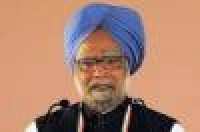UPA's third anniversary blues
Communication shapes image. A poker faced, mostly silent prime minister is not great for conveying that the government is in dynamic mode.
SEVANTI NINAN on the flak the UPA is getting.

Reprinted from Mint, May 24, 2012
TALKING MEDIA
Sevanti Ninan
Don’t let the indignation over curtailed free speech fool you: journalists and commentators in this country still have the best jobs. The government has to actually deliver, the media only has to sit in judgment, with or without some homework done. And it is free to be rude. On Tuesday morning a paper was suggesting that the prime minister and his colleagues were too old to deliver effectively and should call it a day. On Tuesday night a TV channel was suggesting that the prime minister was too silent (“anyone can take snipes at him and he will not respond”) and that he was not “getting enough support from his political masters.” Note the sneering plural, presumably that includes by implication Rahul Gandhi. After which the news anchor suggested that UPA II had at the end of its third year a media management problem.
Poor government performance and continuing corruption are always good news for our business, particularly when there is lots of competition. You sell more when you holler more. Wednesday morning brought another scam headline derived from a CAG report, this time on airport modernization. When the media is doing its job—checking out government implementation, using the Right to Information Act enthusiastically, digging around for discomfiting scoops-- it is making life more difficult for the government of the day. If the government were doing better, it would make life harder for the media!
So does the UPA have a governance problem or a poor communication and negative image problem as those dissecting the prime minister’s celebratory dinner seemed to suggest? Communication shapes image. A poker faced, mostly silent prime minister is not great for conveying that the government is in dynamic mode. If this PM is silent it is a problem, if he speaks it is a problem, according to his critics. And when he and his cabinet are not speaking they are substituted by Renuka Chowdhury and Manish Tewari in TV studios.
The UPA displays a special genius in its choice of spokespersons. If you are politically on the backfoot at least on an occasion like the government’s third anniversary field your more articulate ministers on television and don’t treat it as business as usual?
But the flip side of the communication-is-important argument is this. Do Arun Jaitley’s frequent displays of terrific oratory in the Rajya Sabha suggest that the BJP would be able to govern better than the UPA? Barak Obama has not lost his oratory but will it ensure his re-election? And given the sheer incoherence of what Mamata Banerjee said before she disentangled herself from her mike and walked off a TV show, is communication by itself a virtue?
More likely, acts of governance or non-governance shape the communication that a government has to do, or the images of itself that it generates. Lets just take some recent free speech-related examples.
The CBI’s actions against the Sakshi newspaper in Andhra Pradesh created a storm of negative publicity and turned a substantial section of the media community against it. Was attaching the media properties for an investigation related to Jagan Mohan Reddy’s non-media businesses an act of wise governance in the run up to the by-elections in June? On Wednesday the AP High Court ordered de-freezing of the accounts, putting the government on the backfoot.
Then there is the handling of the cartoon in a NCERT (National Council for Educational Research and Training) textbook by hastening to knock it off. The ‘sixty years of Parliament’ debate in the Rajya Sabha began with the BSP supremo Mayawati professing Dalit hurt and Kapil Sibal hastening to assure removal of the offending cartoon. No stirring oration quoting Jawaharlal Nehru, Ambedkar and others on free expression, suggesting a more nuanced reading of the cartoon, describing other cartoons in the same chapter lampooning Nehru, and suggesting a wider debate on the subject. The decision to ban was bad, and the communication on it was bad. A newspaper report which said that Sonia Gandhi was heard saying to her party men in Parliament that the whole text book should be dropped, does not help the UPA’s image either.
Would communication alone have saved the day in the above cases? The third instance had to do with Meenakshi Natarajan introducing legislation that had the media pouncing upon the Congress again. There, better flock management would have helped.
Meanwhile others are seizing the media initiative to make it look like somebody cares about this benighted land. Gritty problems of human rights (surely ‘social problems’ is too mild a word for life-threatening bestiality) are being revived in the public sphere with a rousing call to sms activism courtesy a Bollywood star, a Murdoch-owned channel and Nita Ambani currently doing a Melinda Gates turn.
The television tear jerker has galvanized an otherwise inactive government. The Congress government in Rajasthan has just announced setting up of fast track courts to try suspicious cases of pregnancy termination. As Aamir Khan would say, Wah! kya baat hai!
Subscribe To The Newsletter






